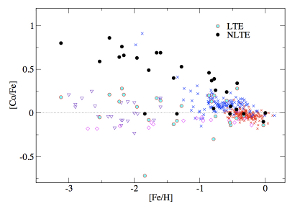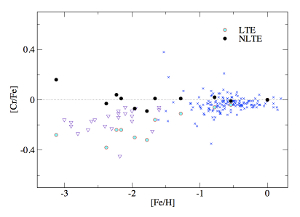|
|  |
A few decades ago, our understanding of the chemical evolution of the Milky Way
relied on two observational facts. First, the chemical composition of old
low-mass stars in the halo closely resembled that of the Sun, scaled to their
low metallicity. Second, in disk stars - including the Sun - the abundances of
elements were identical (within an error of about 50%). These "facts" found a
simple explanation within the monolithic collapse scenario for galaxy formation,
where disk galaxies form through the collapse of a large gas cloud. In this
framework, stellar nucleosynthesis of heavy elements or metals occurred before
the halo collapsed to form the disk, i.e during the first 0.1—0.3 billion years
of the early Galactic evolution. Since then, the average composition of the
interstellare medium (ISM) was thought to remain basically unchanged.
Advances in instrumentation and spectrum analysis methods in the past 20 years
made it possible to compute stellar abundances accurately with an error of only
about 10%. This revealed interesting regularities in the abundance variations
between stars of different stellar populations. For instance, regularities for
alpha-elements (e.g. O, Mg, Ca) or those of the iron peak (22 < Z < 28, i.e. Ti, V,
Cr, Mn, Fe, Co, Ni) indicate that the chemical and dynamical evolution of the
Galaxy is, in fact, very complex. Various substructures of the Milky Way (disk,
bulge, halo, globular clusters) formed on different timescales and by different
mechanisms, including mergers with satellite galaxies as well as accretion of
gas.
Curiously enough, even today the most advanced Galactic chemical evolution
models fail to explain the observed abundance distributions of different iron
peak elements in Galactic metal-poor stars simultaneously. Spectroscopic studies
report decreasing [Cr/Fe] and increasing [Ti/Fe] ratios with decreasing
metallicity, while the [Co/Fe] ratio remains solar down to the lowest
metallicities. (Square brackets denote logarithmic abundance ratios of two
elements in a star relative to their ratio in the Sun.) These trends are
inconsistent with the stellar nucleosynthesis theory, which predicts that stable
odd-Z nuclei (V, Mn, Co) must be suppressed relative to their stable even-Z
neighbours (Cr, Fe, Ni) in a low-metallicity environment.
Although most studies attribute this problem to deficiencies of the Galactic
chemical evolution models, we became concerned about the accuracy of the
spectroscopically determined abundances in stars. In fact, all previous
abundance estimates for iron peak elements contain a systematic error, since
they did not consider the true kinetic equilibrium, also known as non-local
thermodynamic equilibrium (NLTE), of an element throughout a stellar atmosphere.
NLTE calculations take into account the interaction of atoms with the radiation
field explicitly by solving radiative transfer and statistical equilibrium
equations for each of the atomic energy levels and ionisation stages.
We constructed complete atomic models for several iron peak elements and
performed, for the first time, calculation of NLTE spectral line formation for
their neutral and singly-ionized atoms using models of stellar atmospheres. The
synthetic spectra were compared to observed spectra of Galactic metal-poor field
stars and of the globular cluster Omega Centauri to derive element abundances.
Unlike earlier studies, we find that Galactic metal-poor stars are rich in the
odd-Z element Cobalt, but have nearly solar proportions of the even-Z element
Chromium and the odd-Z Manganese relative to iron. The Titanium abundances in
Galactic metal-poor stars mimic the well-known trend of alpha-process elements
(Mg, Ca) with [Fe/H]. Now, the trend of [Cr/Fe] with [Fe/H] can be reproduced by
Galactic chemical evolution models without the need to invoke additional
assumptions, such as peculiar conditions in the ISM. However, the models are
still fully inadequate to represent the halo trends of [Mn/Fe], [Co/Fe], and
[Ti/Fe]. These abundance ratios are largely insensitive to the majority of
parameters in models except for stellar nucleosynthesis, which is expressed
through theoretically computed element yields from stars of various masses and
metallicities. Iron group elements are produced in explosive burning of silicon,
which occurs in massive stars, exploding as Type II supernovae, and in exploding
white dwarfs in binary systems (SN Ia). Thus, our results are useful to
constrain models of supernovae and the properties of their progenitors.
An interesting pattern of Manganese abundances was obtained for giants of the
globular cluster Omega Centauri. The [Mn/Fe] values in the metal-poor
populations of Omega Centauri ([Fe/H] ~ -1.5 ... -1.8) overlap those of Milky
Way halo stars. However, unlike in Galactic disk stars, [Mn/Fe] declines in two
more metal-rich stars in the red giant branch of Omega Centauri. These results
suggest that low-metallicity supernovae of either Type II or Type Ia dominated
the enrichment of the more metal-rich stars in this globular cluster.
The potential of using abundances of iron group elements in old metal-poor
stars is very large. They are useful not only as a diagnostic tool for physical
conditions in stellar atmospheres, but also for understanding nucleosynthesis in
supernovae, chemical enrichment of the galactic ISM, and, hence, chemical
evolution of our Galaxy and galaxies in general.
Maria Bergemann
Publications
M. Bergemann and G. Cescutti, 2010, submitted to A & A
Bergemann et al., 2010, MNRAS 401, 1334-1346
K. Cunha, V. V. Smith, M. Bergemann, N. Suntzeff and D. Lambert, 2010,
submitted to ApJ
|




